Abstract
Mosquito larval surveys were conducted in two urban neigbourhoods, Surulere and Apapa, in Lagos State, Nigeria from July to October 2021. The aim was to investigate mosquito species composition and habitats utilized by these species with the overall goal of generating useful information to guide mosquito surveillance and control activities targeting vector species. Immature mosquitoes (larva and pupa) found were collected using dipping technique and emerged adults were identified using standard morphological keys. Mosquito abundance, diversity and habitat types were also assessed. A total of 2,696 immature mosquitoes were collected from both areas with 90.3% (2,434) collected from Surulere. Three species of mosquitoes; Aedes aegypti, Culex pipiens complex and Anopheles gambiae complex were found in both Surulere and Apapa. One species identified as Lutzia tigripes was found only in Apapa. In Surulere, Cx. pipiens complex had significantly (p < 0.05) the highest relative abundance (59.8%) while An. gambiae complex had the lowest (2.2%). In Apapa, Ae. aegypti had the highest abundance (68.7%) while Lt. tigripes had the lowest (6.9%) but there was no significant difference. Habitat types encountered in both areas included gutters (roadside ditches), ground pools and man-made containers especially used tyres. Larval densities varied significantly (p < 0.05) among species, and habitat types in Surulere but not in Apapa. The observed variations in species composition and abundance between the two urban neigbourhoods suggest different risk for specific mosquito-borne diseases. Integrated vector management tactics such as source reduction through larval habitat elimination and larviciding are recommended.




Similar content being viewed by others
References
Adeleke MA, Adebimpe WO, Hassan AO, Oladejo SO, Olaoye I, Olatunde GO, Adewole T (2013) Larval habitats of mosquito fauna in Osogbo metropolis, Southwestern Nigeria. Asian Pac J Trop Biomed 3:673–677
Agwu EJ, Igbinosa IB, Isaac C (2016) Entomological assessment of yellow fever-epidemic risk indices in Benue State, Nigeria, 2010–2011. Acta Trop 161:18–25
Andreadis TG (1988) A survey of mosquitoes breeding in used tire stockpiles in Connecticut. J Am Mosq Control Assoc 4:256–260
Attaullah M, Gula S, Bibia D, Andaleeba A, Ilahia I, Sirajb M, Ahmada M, Ullaha I, Alia M, Ahmada S, Ullaha Z (2021) Diversity, distribution and relative abundance of the mosquito fauna (Diptera: Culicidae) of Malakand and Dir Lower. Pakistan Braz J Biol 83:e247374
Awolola TS, Oduola AO, Obansa JB, Chukwurar NJ, Unyimadu JP (2007) Anopheles gambiae s.s. breeding in polluted water bodies in urban Lagos, southwestern Nigeria. J Vector Borne Dis 44:241–244
Chan A, Chiang L, Hapuarachchi HC, Tan CH, Pang SC, Lee R, Lee K, Ng L, Lam-Phua S (2014) DNA barcoding: complementing morphological identification of mosquito species in Singapore. Parasit Vectors 7:569
Coetzee M (2020) Key to the females of Afrotropical Anopheles mosquitoes (Diptera: Culicidae. Malar J 19:70
Edwards FW (1941) Mosquitoes of the Ethiopian region. III-Culicine adults and pupae. British Museum (Natural History), London
Erlank E, Koekemoer LL, Coetzee M (2018) The importance of morphological identification of African anopheline mosquitoes (Diptera: Culicidae) for malaria control programmes. Malar J 17:43
Fagbohun IK, Idowu ET, Awolola TS, Otubanjo OA (2020) Seasonal abundance and larval habitats characterization of mosquito species in Lagos State. Nigeria Sci Afr 10:e00656
Gunathilaka N, Karunaraj P (2015) Identification of sibling species status of Anopheles culicifacies breeding in polluted water bodies in Trincomalee district of Sri Lanka. Malar J 14:214
Gillett JD (1972) Common African Mosquitoes and their Medical Importance. William Heinemann Medical Books Ltd, London
Global Vector Hub (2020) Monitoring of mosquito larval habitats (Aedes aegypti and Aedes albopictus). https://globalvectorhub.tghn.org/. Accessed 1 Nov 2021
Jackson N (1953) Observations on the Feeding Habits of a predaceous Mosquito Larva, Culex (Lutzia) tigripes Grandpré and Charmoy (Diptera). Proc R Entomol Soc London 28:153–159
Lagos State Government (2021) Lagos state government official web portal. https://lagosstate.gov.ng/about-lagos/. Accessed 21 Nov 2021
Lagos State Government Ministry of Health (2021) Malaria control program. Available from: http://health.lagosstate.gov.ng/malaria-control-program/. Accessed 21 Nov 2021
Mellanby K (1956) Mosquito populations at ibadan in Nigeria. Bull Entomol Res 47:125–136
Nomhwange T, Jean Baptiste AE, Ezebilo O, Oteri J, Olajide L, Emelife K, Hassan S, Nomhwange ER, Adejoh K, Ireye F, Nora EE, Ningi A, Bathondeli B, Tomori O (2021) The resurgence of yellow fever outbreaks in Nigeria: a 2-year review 2017–2019. BMC Infect Dis 21:1054
Sattler MA, Mtasiwa D, Kiama M, Premji Z, Tanner M, Killeen GF, Lengeler C (2005) Habitat characterisation and spatial distribution of Anopheles sp. mosquito larvae in Dar es Salaam (Tanzania) during the extended dry season. Malar J 4:4
Service MW (1985) Anopheles gambiae: Africa’s principal malaria vector (1902–1984). Bull Entomol Soc Am 31:8–12
Service MW (1993) Mosquito ecology: Field sampling methods. Springer.
Sinka ME, Pironon S, Massey NC, Longbottom J, Hemingway J, Moyes CL, Willis KJ (2020) A new malaria vector in Africa: Predicting the expansion range of Anopheles stephensi and identifying the urban populations at risk. PNAS 117:24900–24908
Surendran SN, Ramasamy MS, de Silva BGDNK, Ramasamy R (2006) Anopheles culicifacies sibling species B and E in Sri Lanka differ in longevity and in their susceptibility to malaria parasite infection and common insecticides. Med Vet Entomol 20:153–156
Walter Reed Biosystematics Unit (2021) Lutzia genus page. Walter Reed Biosystematics Unit Website. http://wrbu.si.edu/vectorspecies/genera/lutzia. Accessed 21 Nov 2021
Wang H, Wang Y, Cheng P, Wang H, Wang H, Liu H, Zhang C, Gong M (2021) The larval density of mosquitos (Diptera: Culicidae) in Jiaxiang County, Shandong Province, China: Influence of Bacterial Diversity, Richness, and Physicochemical Factors. Front Ecol Evol 9:616769
World Health Organization (2017) Global Vector Control Response 2017–2030. 53pp. https://www.who.int/vector-control/publications/global-control-response/en/. Accessed 21 Nov 2021
World Health Organization (2019) Vector Alert: Anopheles stephensi invasion and spread. https://www.who.int/publications/i/item/WHO-HTM-GMP-2019.09. Accessed 21 Nov 2021
World Health Organization (2020) World malaria report. 300pp. https://www.who.int/publications/i/item/9789240015791. Accessed 21 Nov 2021
Acknowledgements
The authors will like to thank the field guides and residents of Surulere and Apapa for their cooperation during the fieldwork. We acknowledge the management of University of Lagos for institutional support given to CLO. Prof. T. S. Awolola is appreciated for the guidance. Prof. Jim Hardie of the Royal Entomological Society, UK, and his mosquito colleagues are acknowledged for their help in identifying Lt. tigripes using the morphological keys of Edwards (1941).
Funding
This work was supported by the Linnean Society of London and the Systematics Association, UK, under the LinnéSys: Systematics Research Fund awarded to CLO in 2021.
Author information
Authors and Affiliations
Corresponding author
Ethics declarations
Conflict of Interest
The authors have no conflict of interest to declare.
Additional information
Publisher's Note
Springer Nature remains neutral with regard to jurisdictional claims in published maps and institutional affiliations.
Rights and permissions
About this article
Cite this article
Oforka, C.L., Omotayo, A.I., Adeogun, A.O. et al. Mosquito species composition in two urban neighbourhoods of Lagos, Southwest Nigeria, based on larval surveys. Int J Trop Insect Sci 42, 2751–2760 (2022). https://doi.org/10.1007/s42690-022-00810-w
Received:
Accepted:
Published:
Issue Date:
DOI: https://doi.org/10.1007/s42690-022-00810-w




